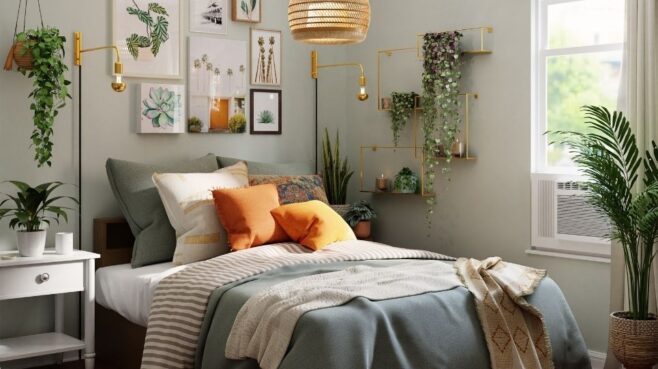There’s numerous ways to improve your sleep pattern from fancy mattresses with temperature control to sleepy time teas and sleep tracking apps, but before you look at any of those you might want to take a look around your bedroom and consider if you’ve chosen the best bedroom colours for sleep.
Sure your mattress and bed is essential for a good night’s sleep but selecting colours that promote sleep can be equally as important.
In this post we’ll have a look at the relationship between your choice of colours in the bedroom and your sleep habits, as well as the best bedroom colours for sleep and colours you should avoid.
How Can Bedroom Colours Affect Your Sleep?
Colours are known to affect a person’s mood and emotions. Colour theory is used in many industries from marketing to design as certain shades can provoke a reaction from your brain.
According to the basic principles of colour psychology, certain colours will make you feel calm and rested, while others can trigger anxiousness and alertness.
Pastels and muted shades are generally considered to promote relaxation which makes them preferable in places where you want to create a serene atmosphere such as the bedroom. Bold, vibrant shades on the other hand have an energising effect so they’re better to use in rooms where you want people to be alert such as the office.
What Are the Best Bedroom Colours for Sleep?
Since colours can promote certain emotions, it would make sense to fill your room with ones that will make you feel relaxed and give off positive energy in the room. The best bedroom colours are the ones that make you feel happy and secure in your room. While the best bedroom colours for sleep may differ depending on your personal preference and interior décor ideas, we have compiled a list of some of the colours that are most often used in bedroom décor to promote better sleep hygiene.
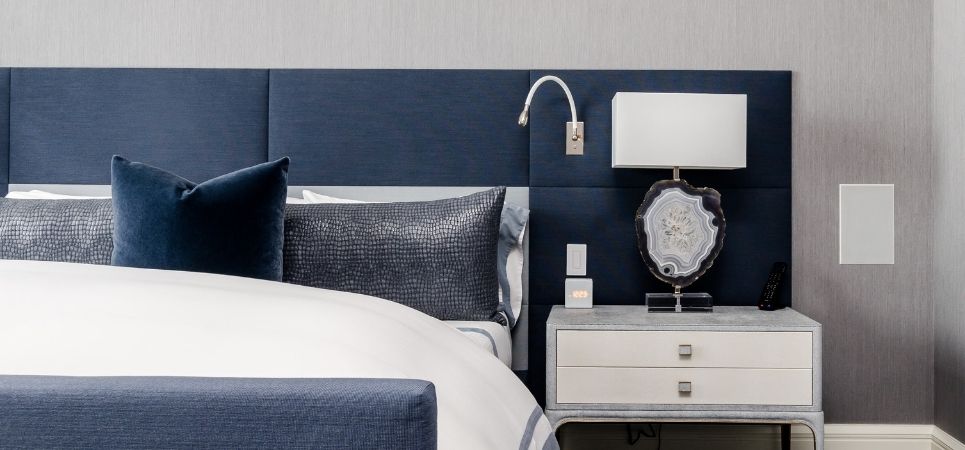
Blue
If you had to imagine a scene that depicts relaxation and serenity, most of the time people envision the colour blue. We see blue everyday around us in the sky or the sea and usually associate it with the feeling of calmness. This colour can also be interpreted as trust and security.
All the emotions you want a bedroom to have. A study conducted by Travelodge found that households with bedroom walls painted in blue receive better sleep compared to any other colour.
When choosing blue shades for your bedroom look for light, pastel colours that match a clear sky.
Beige
Neutral hues like beige are often preferred in interior design. Beige is considered a warmer form of white, and because of that it’s associated with simplicity and calmness. It’s a plain and muted colour that can compliment many other shades around your room.
You can add beige to your bedding, walls or bedroom furniture to create a peaceful atmosphere in your bedroom.
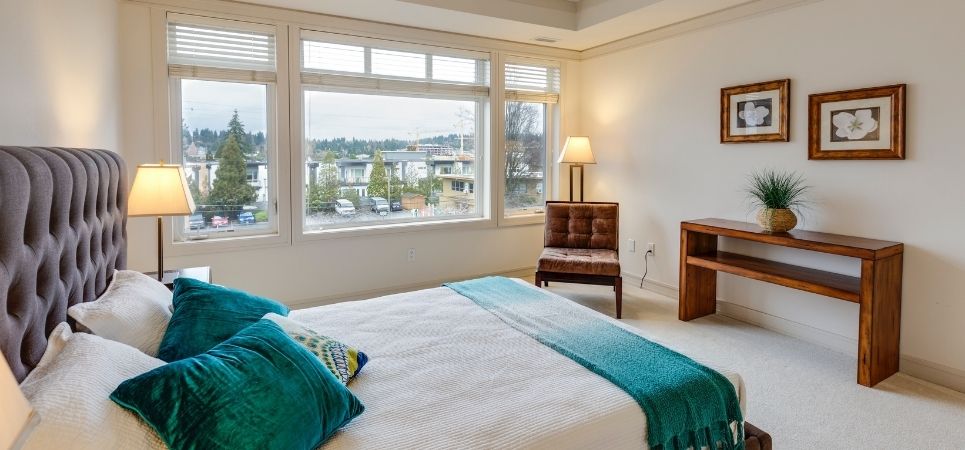
Green
Green is a colour that represents nature, which is why it’s considered beneficial for the body and mind. It’s often linked to tranquillity making it one of the best bedroom colours for sleep.
When it comes to choosing shades of green for the bedroom, the general rule is sticking to pastel colours such as sage green or deep forest green rather than bright flat green hues. Those shades are softer making them better suited for the bedroom.
One great way to involve a bit of green into your bedroom without overdoing it is by adding plants in your bedroom.
Pink
Pink is not often the first colour of choice when it comes to bedroom décor, however, light shades of pink carry certain tenderness and serenity associated with sweetness. If your daily life is particularly stressful, adding a bit of light pink accents can help you feel more at ease.
In case you don’t fancy the idea of light pink walls, this colour can be added as accents throughout the room in the form of a throw or a couple fluffy cushions.
Silver
Silver is a unique and amazing choice if you prefer neutrals, but don’t really like the sterile look of white or beige. Unlike dark grey shades that can often seem gloomy in a bedroom, silver promotes a calm mood.
A silver wallpaper or fabric headboard can add a soft feel to the room. Just be sure to choose a matte shade of silver as sparkly surfaces will reflect the light from your night lamp or ambient lights disturbing your sleep.
What Colours to Avoid in the Bedroom?
While there’s a lot of shades to choose from in the bedroom, there are certain colours that have no place in the room where you sleep. The colours you should avoid in a bedroom include dark and bright colours that can evoke alertness and negative emotions.
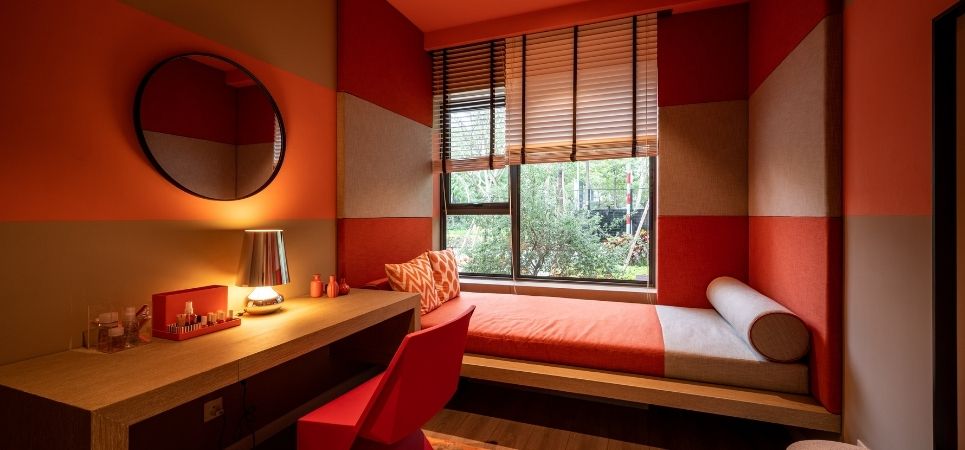
Red
One of the most energetic and intense colours on the spectrum, red represents not only love, but also danger, power and war. Bright shades of red are overpowering and can even promote anger – an emotion you certainly want to keep out of the bedroom. If you want to add some colourful accents to your room opt for a warm blush pink instead.
Orange
Orange is located close to red on the colour wheel which means it has a similar effect on your mood. Its ability to provoke wakefulness and excitement promotes a higher chance of sleep problems. The colour orange is attention-grabbing which is why it’s often used in road safety equipment.
But while bright orange hues can bring in energy, lighter more muted colours are associated with happiness. Instead of plastering bright orange all over your walls, try adding lighter shades in your home décor as prints or a rug.
Purple
Cloaked in mysticism and extravagance, purple carries a similar energy to red, but tends to be associated more with creativity and power. Dark purple hues have the tendency to stimulate the creative part of your brain which according to experts can promote vivid dreams and often even night terrors.
If you’re obsessed with purple, you can keep it in the bedroom as a lighter lavender or lilac shade, which is more serene.
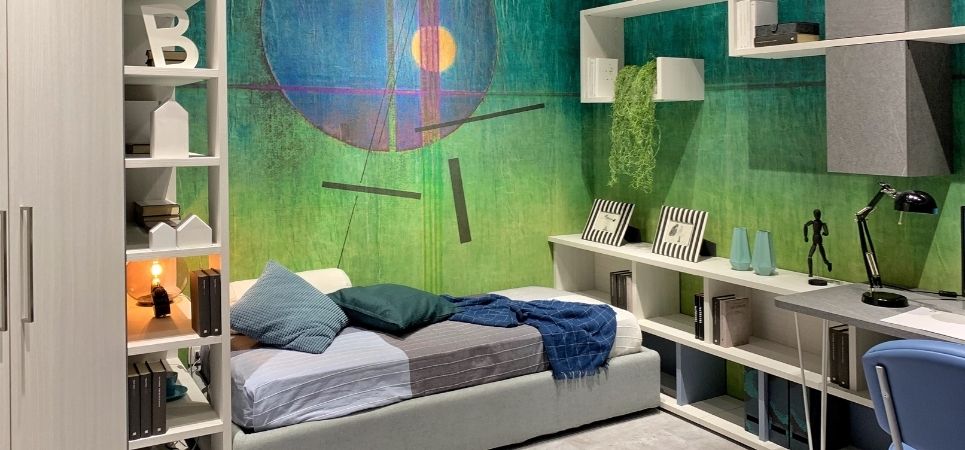
Lime Green
While pastel shades of green such as sage or mint, vibrant greens like lime green should be avoided. Those colours promote creativity and should be left for a space where more energy is needed such as the living room or the kitchen.
Black
No one would paint their bedroom walls black, but adding too much black in your bedroom interior is also not recommended. In colour psychology black is a symbol of negative emotions including grief, anger, fear or sadness, which is the opposite of relaxing. According to the core principles of feng shui, however, using black occasionally in your home interior can have a calming effect.
You can try sprinkling black accessories in your bedroom such as candles, picture frames or small trinket boxes.
